
|
Sale 46
The Millennia Collection
| Lot |
Photo |
Description |
Realized |
Lot 1 |
 |
Celts. Danube Region, c. 2nd century BC. AR (Silver) Tetradrachm (12.03 g); Imitating Philip II of Macedon. "Reiterstumpf or Kroisbach" type. Celticized diademed and beardless head right, with "boxer's" nose. Reverse: Cantering horse left, torso and head of male rider at back, his hair bound with a diadem and tied into a topknot; below, a hobble forms a ground line. W. Kubischek, "Ein Fund keltischer Munzen aus Kroisbach," NZ 43 (1910), pl. 5, 2 (same dies); Lanz 743; KMW 1391; CCCBM I, 154; Göbl OTA, 469. Excellent strike on choice metal. Two small die breaks apparent on obverse. Lightly toned, with abundant luster. A compelling coin, with its bold and unusual image. NGC graded Uncirculated.
One of the opportunities of this auction offering of the Millennia Collection is that so many coins are illustrated in Ira and Larry Goldberg's award-winning reference, Money of the World: Coins That Made History, published in 2007 by Whitman Publishing, LLC. In this volume, a meaningful perspective is recounted through each coin's glory, with fabulous color enlargements artistically reproduced. Many of these pieces form the core of this collection. Indeed, coinage speaks.
Estimated Value $2,500 - 3,000.
Illustrated in Money of the World, coin 21.
View details and enlarged photos
| Realized
$6,613 |
Lot 2 |
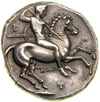 |
Calabria. Tarentum, c. 340-325 BC. AR Nomos (8.16 g). Nude youth, with spears and shield, brandishes lance, on galloping horse right; interspersed in field around, A O T, below, "KAL." Reverse: Taras, on dolphin right, holds up crested helmet, two stars flanking; ethnic at left, below, ONA. Vlasto 554; SNG ANS 973 var.; Fischer-Bossert 775. Minor weakness on youth, otherwise an unusually sharp strike, in exceptional style. Very handsome toning, over pristine lustrous fields. NGC graded About Uncirculated.
Situated on the heel of the great boot of the Italian peninsula, Tarentum was the first safe harbor for westbound ships coming from Greece. Tarentum's fields were enviously verdant, and the sea provided, perhaps even more importantly than fish, the lucrative murex mollusk, which supported the luxury purple dye industry. In the 5th and 4th centuries BC, Tarentum was among the pre-eminent Greek cities. It was cultured, wealthy, and strong. Its craftsmen in gold and the luxury arts were famous and eagerly sought after.
The downfall of the Tarentines would eventually result from their expedient practice of inviting in mercenary generals, from Sparta and other parts of Greece, to defend them from their more warlike neighbors. Around 283 BC the Lucanians and the Bruttians were on the aggressive. Neighboring Greek colonies not trusting Tarentum for aid, sought the help of Rome, who, eager to extend and bolster its influence, agreed promptly. Factions in Tarentum, suspicious of and antagonistic towards Rome, in turn applied to King Pyrrhus of Epirus as a counter to the Roman presence (Epirus was located on the Greek peninsula across the Adriatic Sea from southern Italy). Thus the boot of Italy, and subsequently Sicily, became embroiled in the Pyrrhic Wars, which dragged on for nearly a decade. It is from these conflicts, in which the results were barely conclusive and yet the casualties and losses were excessively high, that we get the term "Pyrrhic Victory." In the end, Pyrrhus departed the field when the tide turned against him, and Tarentum was forced to surrender to Rome. Rome's terms were surprisingly lenient. The city did not learn its lesson, however, and the next generation of Tarentines sided with Hannibal against Rome in the Second Punic War. The Romans once again took Tarentum. This time Rome happily plundered the city and sold tens of thousands of its people into slavery.
Estimated Value $1,500 - 2,000.
View details and enlarged photos
| Realized
$2,760 |
Lot 3 |
 |
Lucania. Metapontum, c. 520-510 BC. AR Nomos-Stater, Achaean standard (8.13 g). Ear of barley; META at right; all within elaborate beaded border. Reverse: Ear of barley in incuse, hatched border around. HN III 1479; Noe 129; SNG ANS 209ff. Sharp, unusually full strike. Beautifully toned, with hints of blue. A particularly nice and lustrous example. NGC graded About Uncirculated.
An ancient Achaean colony, Metapontum was recolonized in the early 6th century BC by inhabitants of the city of Sybaris, under the leadership of Leucippus. Its location on an exceptionally fertile plain off the Gulf of Taranto likely inspired both its name of Metapontum, meaning "beside the sea," and its civic badge, an ear of barley. The barley ear was likewise an emblem of Demeter, goddess of agriculture and harvests, and undoubtedly reflected the source of this city's wealth.
Estimated Value $1,500 - 2,000.
View details and enlarged photos
| Realized
$2,300 |
Lot 4 |
|
Withdrawn
| Unsold |
Lot 5 |
 |
Bruttium. Caulonia, c. 520 BC. AR Nomos-Stater, Achaean standard (8.14 g). Apollo, nude, his hair bound with taenia, advances right, brandishing a laurel(?) branch in his upraised hand, and supporting in his outstretched hand a small running figure, his head turned back, regardant, and also holding a branch in each hand; stag standing to right on dotted ground line, his head turned back regardant; ethnic in left field; all within dotted cable border. Reverse: Reverse of Apollo and stag of obverse, but in incuse, with raised lines detailing small figure, stag's antlers, and laurel branch; border with hatching. Cf. Kraay/Hirmer 259; HN III 2035; Noe 2p (this coin); Sear 252 = BMC p. 335, 9 (same obverse die); SNG ANS 141. A superb example, in lovely, robust and exhuberant archaic style. Beautifully toned and sharply struck. Rare this nice. NGC graded About Uncirculated.
Many of the most revered and artistic Greek coins were minted in Southern Italy and Sicily, the area called Magna Graecia. The city of Caulonia was repeatedly razed; her coinage reflects these troubled times. Finally, in 389 BC under Dionysios I, the city became a completely abandoned and utterly ruined town. Constant throughout her numismatic history, however, was the symbolic use of the Delphian Apollo figure, most wonderfully depicted on the town's archaic staters, or nomoi. Both "stater" and "nomos" (as singular nouns) denote the standard unit of coinage, with "nomos" being more frequently used in Southern Italy.
Numismatists like Jacob Hirsch produced some of the finest sale catalogues early in the 20th century. The time consumed in preparing plaster casts of each of the coins, plus the expense of the beautiful black-and-white collotype plates, placed these references above and beyond what was normally seen. It is a great pleasure for today's numismatists to refer to past appearances, or provenances, of these selected gems of ancient coinage. Normally we don't have the privilege of knowing the previous whereabouts of coins, but each of these present offerings will have the future prestige of "ex Millennia Collection."
Estimated Value $12,000 - 15,000.
From the de Guermantes Collection, ex Jacob Hirsch, Liste XVII, February 1907, no. 291; and J. Hirsch, Liste XVI, December 1906, no. 159. Illustrated in Money of the World, coin 13.
View details and enlarged photos
| Realized
$23,000 |
Lot 6 |
 |
Bruttium. Rhegium, c. 320 BC. AR Tetradrachm (17.31 g). Laureate head of Apollo left; ethnic at left. Reverse: Facing head of lion, eyes looking to left. Basel 229; Herzfelder 115; SNG ANS 676. Boldly struck and lustrous. One of the finest known examples, and one of the notables of Magna Graecian coin art. Rare. NGC graded Uncirculated.
While the earlier coins of Rhegium clearly show the lion's head as the obverse, this later issue is an exception. In ancient numismatics we judge which side of the coin was struck by the lower (or anvil) die, and call that side the obverse. The minting process left the upper die, or reverse, with a concave appearance, but gave the obverse a certain convexity. Therefore, it doesn't matter which side shows a "head"; the distinction between obverse and reverse lies with the position of the dies.
Estimated Value $35,000 - 40,000.
Illustrated in Money of the World, coin 14.
View details and enlarged photos
| Realized
$120,750 |
Lot 7 |
 |
Sicily. Leontini, c. 430-425 BC. AR Tetradrachm (17.27 g). Laureate head of Apollo left. Reverse: Lion's head with open jaws to left, three barley grains about head, bay leaf behind; ethnic in field around. Rizzo pl. 24, 4 (same dies); SNG ANS 257 (same dies); Boehringer 55 (same dies). Deeply toned, and highly lustrous. NGC graded Uncirculated.
Before this hoard of virtually mint state tetradrachms of Leontini was unearthed, there were very few specimens which could come close to the freshness of the dies and high condition of the example here offered. The employment of the head of the lion is a punning allusion to the name of this city, which lies northwest of Syracuse. Some other cities which used a visual reminder of the city where issued would include Rhodes (rose - "rhodos" in Greek) and Phocaea (aquatic seal - "phoke"). This classification of coin design is termed "speaking type" or "type parlant." A fascinating array of Greek coins could be formed using just this focus.
Estimated Value $2,000 - 2,500.
View details and enlarged photos
| Realized
$3,450 |
Lot 8 |
 |
Sicily, Messana, c. 412-408 B.C. AR Tetradrachm (17.19 g). The nymph Messana, in long chiton, and holding goad and reins, in mule-drawn biga to the left; above, Nike flies right to crown her; in exergue, two dolphins meeting. Reverse: Hare springs to the left above ear of grain; above, eagle flies left. C. Boehringer, Rekonstrukzion des Schatzfundes von Ognina 1923, SNR 57, 1978, pl. 33, 157 (this coin); Caltabiano, Messana, AMUGS XIII, nos. 622.6 and 17 (this coin); Schefold, Meisterwerke griechischer Kunst, 479 (this coin). Both sides well struck and sharp, on choice metal. Finely toned and lustrous. A superior example of this issue. NGC graded Extremely Fine.
Messana, under the name of Zankle, was one of the oldest Chalcidian colonies established in Sicily. The hare motif on the reverse is thought to commemorate the introduction of this animal to Sicily by Anaxilas of Rhegium around 490 BC, but it more likely appears on the city's coinage as a symbol of Pan, perhaps the most favored deity of the residents. Messana was blessed with a fine harbor, but it was its control of the straits of about three and a half miles wide, that divided Sicily from the toe of Italy, with its important sea traffic, that was the city's true source of wealth.
Estimated Value $12,000 - 14,000.
Ex Hess-Leu 9, April 2, 1958, no. 67; and from the Ognina Hoard of 1923 (IGCH 2120). Incidentally, it should be noted that Caltabiano mistakenly lists this coin twice, as 622.6 and 17, and also gives it, under 622.6, the incorrect provenance of Hess-Leu 1964. Illustrated in Money of the World, coin 15.
View details and enlarged photos
| Realized
$21,275 |
Lot 9 |
 |
Sicily. Syracuse. Deinomenid Tyranny, 485-466 BC. AR Tetradrachm (17.10 g), struck c. 483-480 BC. Charioteer in walking quadriga right; Nike flying right to crown the horses. Reverse: Diademed head of Arethusa right, hair bound into krobylos; four dolphins around, clockwise; ethnic around and between. Boehringer 62; Rizzo pl. XXXIV, no. 20. Attractively toned, and retaining much luster in the fields. With splendid late archaic portrait of Arethusa -- perhaps the best in this series. NGC graded About Uncirculated.
Syracuse, the greatest and richest city of ancient Sicily, was established as a Corinthian colony about 733 BC. The earliest settlement was on the island of Ortygia, in the northeast corner of the wide bay, and benefited from a fresh water spring belonging to the nymph Arethusa. Strategically placed for both commerce and shipping, Syracuse immediately flourished. Within a century of her own founding, the city itself was establishing colonies along the coast of Sicily. Syracuse's wealth was evident early on, in that it was the only Sicilian mint to issue tetradrachms from the inception of its coinage, circa 515 BC.
Estimated Value $7,000 - 8,000.
Ex Leu 59, May 17, 1994, no. 65; and, Numismatica Ars Classica 4, February 27, no. 56.
View details and enlarged photos
| Realized
$16,100 |
Lot 10 |
 |
Sicily, Syracuse, c. 460-450 B.C. AR Tetradrachm (17.22 g). Bearded charioteer in walking quadriga right; Nike flying right to crown the horses; in exergue, ketos swimming right. Reverse: Diademed head of Arethusa right; four dolphins around, clockwise; ethnic along right. Boehringer 483; Jameson 760; SNG ANS 151. Finely centered and sharply struck on a surprisingly roomy flan. Attractively toned, with handsome early classical portrait of Arethusa. NGC graded Extremely Fine.
Estimated Value $4,000 - 5,000.
View details and enlarged photos
| Realized
$6,325 |
Lot 11 |
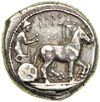 |
Sicily, Syracuse, c. 510-490 B.C. AR Tetradrachm (17.16 g). Attic standard. Charioteer in long chiton, and holding reins, in walking chariot right; ethnic in two lines above. Reverse: Within small circular incuse the head of Arethusa left, a roll of hair frames the face, the rest as rows of parallel dots depending along the neck, this within a swastika-like, pellet-textured quartered incuse square. Weber 1549 (these dies); Kraay/Hirmer 72; Rizzo pl. 34, 4; Boehringer, Die Munzen von Syrakus, 9; SNG ANS 2. Well struck in high relief, on full flan of excellent metal. Light to medium toning. Rare. NGC graded Extremely Fine.
This coin is noteworthy for being the first of the artistic formula that would dominate Syracusan tetradrachms for the next two and a half centuries -- the obverse with charioteer and team, the reverse with a portrait of Arethusa. While the motifs for the tetradrachms would remain for the most part unchanging, the coinage can be considered ingeniously innovative -- the horses were utilized to denote the coin's denomination. Thus four horses comprised the team on tetradrachms; a biga of two horses, or other paired horses, were seen on didrachms; while drachms made use of only a single horse. The distinctive quartered incuse square seen in this issue reveals the influence of early northern Greek money then in circulation in Sicily.
Estimated Value $12,000 - 14,000.
Ex M & M sale 37, 1968, lot 90. Illustrated in Money of the World, coin 16.
View details and enlarged photos
| Realized
$23,000 |
Lot 12 |
 |
Sicily, Syracuse, c. 404-400 B.C. AR Decadrachm (43.25 g). Signed by Kimon, once on the obverse, and twice on the reverse. Charioteer, in long chiton, and holding goad and reins, in racing chariot to the left; above, Nike flies right to crown him; upper edge of exergual line, signed KIMON; in exergue, panoply of arms, in tiny letters at bottom AΘΛA. Reverse: Head of Arethusa left, hair bound in ampyx and sphendone, inscribed with signature K, also wearing necklace and pendant earring; around, four dolphins, with that below the neck being signed KIMON; ethnic at upper right. Basel 479; Gulbenkian 303; Jongkees 3; Kraay/Hirmer 118 (same obverse die, earlier state); Rizzo LII, 3; SNG Lloyd 1409. Usual light obverse die rust. The reverse finely centered and struck. Lightly toned, with the thin die break over the eye, diagnostic of this later die state. Extremely Rare. One of the great masterpieces of the die engraver's art for the Greek series. NGC graded About Uncirculated.
The military and political fortunes of the mercenary general, Dionysius, rose and solidified during the renewed imperialistic expansionism of Carthage against the Greek cities of Sicily, beginning in 409 BC. By the winter of 406-405 BC, Dionysius became tyrant and stregos of Syracuse, the premier city of Sicily. During his reign (405-367 B.C.), he fought three wars against the Carthaginians, handing them defeat after defeat, and confining the Carthaginians to their older territorial dominions in the western part of Sicily. This accomplished, Syracuse, with its rapidly increasing prestige and wealth, began its own program of territorial and political expansionism, eventually controlling in some form most of the "foot" of Italy. Under Dionysius, Syracuse became the most splendid and the best fortified of all Greek cities. Its naval power was vastly increased, likewise, until its fleet was the most powerful in the Mediterranean.
Emulating previous Sicilian tyrants of the earlier 5th century, who cut such grand figures for themselves in the arenas of culture, the pan-Hellenic games, or the arts, Dionysius introduced the large and ostentatious decadrachm denomination to Syracusan coinage, and entrusted the die production to two of the finest numismatic artists of the period. The decadrachms were produced in two series, one by Euainetos, and this, perhaps the finer of the two, by Kimon.
The above coin is one of the true masterpieces of Greek coinage. Interestingly, the conception of Arethusa changes over the period the dies were being produced. That on his first die was a pretty, young girl, displaying an air almost of innocence. This more mature rendering of Arethusa is Kimon's second type of the nymph, and she is indeed a woman of the world. Even so, the fact that Kimon signed the two dies a total of three times assuredly shows how proud he was of this creation. The like regard held for this coin in modern times is reflected in the fact that not one of the truly great collections of Greek coins lacks a specimen.
Estimated Value $60,000 - 70,000.
Illustrated in Money of the World, coin 17.
View details and enlarged photos
| Realized
$166,750 |
Lot 13 |
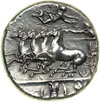 |
Sicily, Syracuse, c. 405-390 BC. AR Decadrachm, style of Euainetos (43.05 g). Charioteer, in long chiton, and holding goad and reins, in racing chariot to the left; above, Nike flies right to crown him; in exergue, panoply of arms set on two steps. Reverse: Head of Arethusa left, her hair wreathed in cereal grains, also wearing necklace and pendant earring; around, four dolphins, behind neck a cockleshell; ethnic at upper right. SNG Lockett III, 991 (this coin); Gallatin, F.VIII/R.XV; cf. Dewing 915 for obverse, 916 for reverse; cf. Gulbenkian 317. Handsomely toned, with especially fine strike from fairly fresh dies -- the detail to the horses remarkably choice. Usual slight obverse die rust and a spot or two of trivial porosity. One of the widely acknowledged masterpieces of Greek numismatics, both in antiquity and in modern times. NGC graded Extremely Fine.
Estimated Value $50,000 - 60,000.
Ex Lockett Collection: Glendining & Co., sale of Oct 28, 1955, as lot 895; this the best of the Lockett Euainetos types. Illustrated in Money of the World, coin 18.
View details and enlarged photos
| Realized
$201,250 |
Lot 14 |
 |
Siculo-Punic. Machanat series, c. 330-325 BC. AR Tetradrachm (17.23 g). Diademed head of Arethusa-Persephone-Tanit left, hair wreathed in grains, with necklace and ornate pendant earring. Reverse: Horse prancing to right, before date palm. Jenkins 126; Gulbenkian 363. In high relief and handsomely toned. Among the prettiest and most charming die pairings in the Siculo-Punic series; the elegant head is a worthy recreation of Euainetos' decadrachm showing Arethusa. NGC graded About Uncirculated.
By about the 1000 BC, the country of Phoenicia, which had become a dominant mercantile power in the eastern Mediterranean in the previous two centuries, was establishing permanent trading communities in the western Mediterranean -- in Spain, in Cyprus, on Malta, and what would become their greatest colony, Carthage, in north Africa, and along the north and west coasts of Sicily. Within two centuries colonists from Greece were likewise settling throughout the rest of the island. For the next several hundred years the island would suffer the periodic warfare and depredations of these two ethnic entities struggling for commercial dominance of the fertile and rich island. This is particularly so after 450 BC, when Phoenicia's influence and power was on the wane and that of the younger, more assertive, Carthage on a rapid rise.
Estimated Value $6,000 - 7,000.
Ex M. Ley collection, Lanz 70, November 21, 1994, no. 30.
View details and enlarged photos
| Realized
$31,050 |
Lot 15 |
 |
Siculo-Punic. Machanat series, c. 320-315 BC. AR Tetradrachm (17.09 g). Diademed head of Arethusa-Persephone-Tanit left, hair wreathed in grains, with necklace and pendant earring; four dolphins around. Reverse: Horse's head to left, date palm behind; below, Punic inscription: 'Mmhnt = "people of the camp." Jenkins pl. 14, no. 188; Rizzo pl. LXVI, no. 10. An exceptional piece, perfectly struck and centered on a broad flan; lustrous. NGC graded About Uncirculated.
In their continuing struggles over empire and commerce, between a resurgent Carthage and the Greek cities of Sicily, dominated by Syracuse, this coin is part of a large issue produced by a new Carthaginian leader, Hamilcar, son of Gisgon. These were in response to military and political, one might say, "assertions" on the part of the tyrant Agathokles of Syracuse, but surely viewed as aggressions by the Carthaginians against their interests. The inscription thus denotes these coins as military issues, produced either at a large headquarters mint, or perhaps even a traveling mint accompanying the operations forces. The features of the goddess on this coin are quite refined for this series, but still reveal the hand of a Punic die engraver rather than a Greek.
Estimated Value $7,000 - 8,000.
Ex Leu 65, May 21, 1996, no. 121.
View details and enlarged photos
| Realized
$16,675 |
Lot 16 |
 |
Kings of Macedon. Philip II, 359-336 BC. Gold Stater (8.60 g), Abydus mint, struck c. 323-319 BC. Struck under Philip III. Laureate head of youthful Apollo right. Reverse: Charioteer driving fast biga right, with kentron in right hand and reins in left; Ξ and horse's leg beneath far horse; graffiti "A" below driver's hand. Thompson, Philip --; ADM II, Series V, 88; SNG ANS 298. Light reverse edge scrapes at 4-6 o'clock, otherwise a splendid example, with choice centering, and beautifully struck. Wonderful late classical style; the reverse, especially, a work of art for this series. Lustrous. NGC graded Choice Almost Uncirculated.
Estimated Value $4,000 - 5,000.
Illustrated in Money of the World, coin 8.
View details and enlarged photos
| Realized
$10,063 |
Lot 17 |
 |
Kings of Macedon. Philip II, 359-336 BC. AR Tetradrachm (14.38 g), Amphipolis mint, struck c. 355-348 BC. Lifetime Issue. Laureate head of bearded Zeus right. Reverse: King with hand raised, on high-stepping horse left, he with chlamys and kausia, and the horse with bridle and ornate blanket; name above and around, at left, M and head of trident. Le Rider 27a (this coin); SNG ANS 462. A splendid example of what is one of the very early issues of the Amphipolis mint. The head of Zeus rendered with a dignified elegance; the artistry of the reverse very good, especially for this mint. Finely toned and rare. Obverse with faint evidence of overstriking, but undertype uncertain. NGC graded Extremely Fine.
Estimated Value $3,000 - 3,500.
It is this coin type that is believed to commemorate Philip II's victory at the Olympic Games.
View details and enlarged photos
| Realized
$4,600 |
Lot 18 |
 |
Kings of Macedon. Alexander III, the Great, 336-323 BC. Gold Distater (17.27 g), Aegeae mint, struck c. 336-323 BC. Head of Athena right, wearing triple-crested Corinthian helmet, adorned with coiled serpent. Reverse: Nike standing left, holding wreath in extended hand, stylis in other; vertical thunderbolt at left, monogram below. Price 191. A superb example, with choice centering, beautifully struck in high relief, with a delicate touch of red toning -- mostly on the reverse. NGC graded Choice About Uncirculated.
Continuing to utilize the wealth of Macedon's mines, which Alexander's father, Phillip II, had employed to finance his own and Macedon's imperialism, Alexander set himself up as conqueror and empire builder. In the process, his massive minting of coin would in essence create a new world class currency, in the manner of today's dollar, or like that once held by the silver "owls" from the time of Athens' imperial ascendancy. In adopting the Attic weight standard, Alexander's coinage would easily fit into a scheme that had already been established, and thus cause no new disruptions to trade. In addition, Alexander's insistence on the obvious and easy 10:1 ratio of exchange between silver and gold made for a system that was recognized and utilized even in cities that adhered to their traditional minting standards. The ease of use and rationality of Alexander's coining standards quickly came to serve as the basis for financial systems throughout much of the Greek world, not only in Alexander's time, but for a number of centuries afterwards.
Estimated Value $10,000 - 12,000.
View details and enlarged photos
| Realized
$25,300 |
Lot 19 |
 |
Kings of Macedon. Alexander III, the Great, 336-323 BC. Gold Distater (17.23 g), Amphipolis mint, struck c. 324-318 BC. Head of Athena right, wearing triple-crested Corinthian helmet, adorned with coiled serpent. Reverse: Nike alighting or walking left, holding wreath in extended hand, stylis in other; head of trident at left. Cf. Price 167; note also, Troxell, ANSNS XXI, no. 546, Group C, same obverse die, but with fulmen reverse symbol (also per Troxell, nos. 540 [kantharos], and 470 [fulmen] from same obverse as 546, while no. 543 [ex NFA I, 3-20-75, no. 82] appears to be a slightly earlier die state, before the chipping begins to appear at the chin the author notes of this small group that only 17 coins are known, struck from only three obverse dies, with the bulk from this die, and the trident reverse being the least represented symbol in this group. A stunning example, with choice centering, and beautifully struck in high relief from among the prettiest dies in the series. The lovely obverse die of relatively short duration, as it is already showing faint die cracks along the periphery. Very Rare. NGC graded Choice About Uncirculated.
Estimated Value $30,000 - 35,000.
Illustrated in Money of the World, coin 9.
View details and enlarged photos
| Realized
$230,000 |
Lot 20 |
 |
Kings of Macedon. Alexander III, the Great, 336-323 BC. Gold Stater (8.61 g), uncertain Macedonian mint, struck c. 330-320 BC. Head of Athena right, wearing triple-crested Corinthian helmet, adorned with coiled serpent. Reverse: Nike standing left, holding wreath in extended hand, stylis in other; vertical thunderbolt at left. Cf. Price 164. A very handsome example, with choice centering, beautifully and fully struck in very high relief, and highly lustrous. With splendid mint surfaces. NGC graded Choice Uncirculated.
Collectors of ancient Greek coins, early into their hobby, become quickly aware of just how available and how great the quantity is of coins of this seminal figure of Western history. The core of the wealth of Alexander's empire resided in the Persian Empire that Alexander seized. Even in its senescence, the Achaemenid Empire remained the largest and wealthiest world empire up to that time in history, and would only see its rival centuries later under the Romans. With Alexander as King and sole ruler, and thus "owner," of the Persian territories and its assets, plus those of the additional lands accumulated by his conquests, he can be said during his brief decade of glory to have been the richest man in the world: the possessor of wealth almost beyond comprehension.
Estimated Value $2,500 - 3,000.
View details and enlarged photos
| Realized
$5,750 |
Lot 21 |
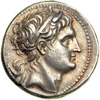 |
Kings of Macedon. Demetrios Poliorketes, 305-284 BC. AR Tetradrachm (16.98 g), Amphipolis mint, c. 290-289 BC. Diademed head of Demetrios right, wearing bull's horn. Reverse: Poseidon, nude, standing left, his right foot on rock, arm resting on knee, holding trident with left hand; regal titles, monograms in field. Newell 116 (obverse CXI). Nicely toned, with excellent portrait. NGC graded Extremely Fine.
The son of Antigonus Gonatus ("Antigonus the One-Eyed," who was one of Alexander the Great's companions-in-arms), Demetrios Poliorketes ("the Besieger") spent most of his career trying to carve out a kingdom for himself somewhere, anywhere, along with attempting to reclaim his father's forfeited Asian domains, lost in the battle of Ipsus in 301 BC. His warmongering and mettlesomeness ultimately drove his enemies into an alliance, which forced Demetrios out of Macedon. He was eventually to die in Syria, in captivity. However his son, also named Antigonus, was able to establish himself as king of Macedon, fathering a dynasty, which lasted until Roman times.
Estimated Value $3,000 - 3,500.
Ex Tkalec 28, October 1994, no. 82. Illustrated in Money of the World, coin 10.
View details and enlarged photos
| Realized
$6,325 |
Lot 22 |
 |
Thrace. Ainos, c. 359-356 BC. AR Tetradrachm (14.73 g). Three-quarters facing head of youthful Hermes, turned slightly towards the left, wearing petasos with beaded band. Reverse: Goat standing right, eagle before; ethnic above. May, Ainos, 434 var. (A263 / unlisted reverse die, but cf. P310); Von Fritze, Ainos, pl. ii, 2 (same obverse die). Dies of elegant style, finely centered and sharply struck, on flan of extraordinary size. Deeply toned. Exceptional! NGC graded About Uncirculated.
While there were many guises of Hermes in Greek mythology, he is most often depicted as a youth wearing the petasos, or flat-brimmed hat of the traveler. If full figured, Hermes carries the caduceus and wears winged sandals and the chlamys, or short cloak. Of the coins which portray Hermes, the silver coins of Ainos are the most charismatic. All the tetradrachms are rare and believed to have been minted as special issues, while the much more plentiful smaller denominations served the needs of daily commerce and payment of the military. This particular specimen is one of the last tetradrachms to have been struck before the city was absorbed into Philip II's Kingdom of Macedon.
Estimated Value $15,000 - 17,500.
View details and enlarged photos
| Realized
$42,550 |
Lot 23 |
 |
Thracian Kingdom. Lysimachos, 323-281 BC. Gold Stater (8.54 g), Pella mint, struck 286/5-282/1 BC. Diademed head of deified Alexander right; horn of Ammon above ear. Reverse: Athena Nikephoros seated left, holding up Nike in extended hand, spear leaning against foot; monogram beneath arm, in exergue, K; letter on throne. Fr-127; Thompson 241; Jameson IV, no. 2464 (same dies). A few light marks on back. Sharp and finely centered. With excellent high relief portrait, and lustrous. NGC graded Choice About Uncirculated.
Estimated Value $4,000 - 4,500.
Illustrated in Money of the World, coin 11.
View details and enlarged photos
| Realized
$8,625 |
Lot 24 |
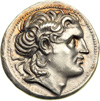 |
Thracian Kingdom. Lysimachos, 323-281 BC. AR Tetradrachm (17.19 g), Amphipolis mint, struck 288/7-282/1 BC. Diademed head of deified Alexander right; horn of Ammon above ear. Reverse: Athena Nikephoros seated left, holding up Nike in extended hand, spear leaning against foot; monogram beneath arm; at right, another monogram. Thompson 201; Müller 543 var. (position of monograms). Finely centered and boldly struck, with high relief portrait. Lightly toned, with areas of russet and gold about the portrait. Lustrous and choice. NGC graded About Uncirculated.
This and the previous coin offered are responsible for the conception of the large-sized British penny: Athena has been replaced with a classical representation of Britannia, while the monarch's head was substituted for that of the deified Alexander the Great. While silver denominations had been the coin of the realm, the fourth century BC saw a large influx of gold and bronze coinage as well.
Estimated Value $2,000 - 2,500.
Ex Tkalec Auktion (2-19-01), lot 74.
View details and enlarged photos
| Realized
$5,060 |
Lot 25 |
 |
Thrace. Island of Thasos, c. 475-440 BC. AR Stater (8.62 g). Nude, ithyphallic satyr rushing to right, in archaic kneeling-running position, holding draped, protesting nymph, who wears bracelets on her arms. Reverse: Quadripartite incuse square. SNG Cop. 1010, 1011. Well centered, toned. Struck from a die of the finest late Archaic style. An outstanding example of this prolific coinage. NGC graded Extremely Fine.
The island taking its name from one of the mythical sons of Poseidon, the earliest settlers in the 8th century BC were Phoenicians. Greek colonists later supplanted these peoples. The natural assets of the island were blessed indeed. Besides the prolific gold mines on the island, Thasos also had controlling interests in many of the silver mines on the Thracian mainland, opposite them. This allowed them to form and maintain a powerful navy and a substantial maritime industry. Exports from the island included quarried marble, nuts, and wine. Wine production was a major industry for the island. Their wine was dark, heavy, and famous for its rich bouquet. It was said to be one of the best, and most expensive of the ancient wines, and was exported in large sealed amphorae to as far afield as Susa (in Iran), Egypt, Magna Graecia, and the Black Sea area.
The prevalence of Dionysian subjects for their coinage relates to the fact that Dionysius was one of the two chief gods worshiped on Thasos. The god's main sanctuary was atop Mt. Pangaeus, was not far from Thasos; his worship dominated the Thraco-Macedonian religion of the region. Additionally, the satyr abducting the struggling nymph on their wide ranging coinage may be in part a reference to the potency of their wines -- since the mythical satyrs had a reputation for becoming extremely uninhibited when drunk.
Estimated Value $2,500 - 3,000.
View details and enlarged photos
| Realized
$3,680 |
Lot 26 |
 |
Thrace. Island of Thasos, c. 435-410 BC. AR Stater (8.78 g). Nude satyr to right, in archaic kneeling-running position, holding draped, protesting nymph; dolphin at right. Reverse: Quadripartite incuse square. Gulbenkian 464 var.; SNG Cop. 1017; cf Dewing 1324. Well centered, lightly toned. Superb example, in finest classical style. NGC graded About Uncirculated.
As significant as wine was to Thasos, so too was the wine-associated cult of Dionysus -- not to just the island, but throughout the whole region in particular. Dionysus, known as the god of fertility and wine, was one of the most important gods to the Greeks. Legends concerning him are profuse and contradictory, but his origins are most ancient and his myths preserve some religious traits that can be considered primitive in the extreme. Perhaps a deity of Thracian origin, he was on the one hand (according to Orphic legend) known as Dionysus Zageus, son of Zeus and Persephone. In other legends he was the son of Zeus and Semele. As a child he was raised by nymphs on Mount Nysa, where he would one day invent the art of wine making. When grown to manhood, he wandered through many lands, teaching men the lore of the vine, along with the mysteries of his cult. Accompanying him was an entourage of characters, including maenads, and nymphs. His worship was ecstatic, and women figured prominently in the rites.
On the archaic-style coins up to about 465 BC - the satyrs are aggressively ithyphallic, with animal features, and the female gesticulating in protest over her abduction. By the time of the coin above, their art has been filtered through the civilizing conventions of classical art, best seen on Athens' famed Parthenon. Now the harmonious and balanced composition shows the creature as an older, but fit man (although he does still retain the horse's ear and tail). He now carries the nymph, rather than clutching her tightly. Similarly with the nymph, she appears surprised, but not overly resistant, as in the earlier versions. These changes may not just be artistic reconfigurations, but may well reflect changes in the rites of Dionysus as well. Subsequently, his worship became more formalized, calmer. It was believed that the wine and ecstatic frenzy would not just liberate and unburden man, but that it could prove inspirational -- that it could even endow him directly with "divine creativity."
Estimated Value $2,500 - 3,000.
Illustrated in Money of the World, coin 7.
View details and enlarged photos
| Realized
$5,290 |
Lot 27 |
 |
Thessaly. Larissa, c. 350-325 BC. AR Didrachm (12.16 g). Head of the nymph Larissa, facing and turned slightly to left, wearing necklace, with hair partially bound in ampyx. Reverse: Bridled horse walking to right; ethnic around. BMC 55; Gulbenkian 474; Herrman Group VII, pl. V, 1-2. Attractively toned, with iridescent golds and russets in the recesses. Rare. NGC graded About Uncirculated.
Unlike most regions of Greece, Thessaly contains the highest percentage of flat land and lowlands. Basically, it is comprised of plains ringed by mountains, which cut much of it off from the sea to the south, and pretty much isolates it from its neighbors. Thus its economy likewise differed from that of much of Greece. Rather than vine and olive cultivation, supplemented by sheep and goats, Thessaly's plains produced cereals and wheat, along with ample pasturage for cattle, and for a breed of horses the region became particularly famous for. Thus cattle and horses appear as consistent motifs in the region's coinages. The bull about 400 BC and earlier; the horses throughout the 4th century.
The chief town of Thessaly bore the name of the nymph, Larissa. She is seen in two mythological traditions as either the mother or the daughter of Pelasgus, whose name is the eponym of the Pelasgians, the earliest people of the region. In any event, her progeny constituted the ancestors of the three main tribes that populated Thessaly. It will be noted on the coin above that Larissa's portrait is closely modeled on the famed frontal portrait of Syracuse's Arethusa, engraved by Kimon for a Tetradrachm issue of about 406 B.C. The Syracusan coin was widely admired among the Greeks, and served as the prototype for many subsequent frontal portraits on a variety of coins from other cities.
Estimated Value $5,000 - 6,000.
View details and enlarged photos
| Realized
$10,063 |
Lot 28 |
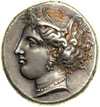 |
Locris. Locris Opuntia, c. 382-336 B.C. AR Stater (12.27 g). Head of Persephone left, wearing triple-pendant earring and necklace, hair wreathed with grains. Reverse: Ajax advancing right, nude but for crested Corinthian helmet, holding sword and shield adorned with running griffin; star to lower right, broken spear on ground; ethnic at left. Gulbenkian 491; Dewing 1477; cf. SNG Cop. 43; BMC p. 4, 27 var. (no star). A superb example, with choice centering on especially fine metal. NGC graded About Uncirculated.
The reverse of this beautiful stater depicts Ajax, the Locrian leader in the Trojan War. Sometimes called Ajax the Lesser, he set sail against Troy with 40 ships. Ajax became the national hero of Locris and his image formed a distinctive reverse type for almost all the silver issues of Locris Opuntia, which was situated in central Greece.
Estimated Value $6,000 - 7,000.
View details and enlarged photos
| Realized
$10,063 |
Lot 29 |
 |
Attica. Athens, after 449 BC. AR Tetradrachm (17.21 g). We would grade this coin a superb Extremely fine. Head of Athena right, in ornamented, crested helmet. Reverse: Owl right, ethnic and olive sprig in fields. Starr pl. xxii, 2'. Sharp strike on larger flan, showing much of the helmet's crest; scarce thus. Attractively toned. NGC graded About Uncirculated.
Probably the most identifiable and beloved of all Greek coins, the owls of Athens were treasured when first minted, just as they are today, 2500 years later. They were produced in immense numbers during most of the fifth century BC; their consistent weight and fineness of metal was appreciated all over the Greek world.
Estimated Value $3,000 - 3,500.
Illustrated in Money of the World, coin 4.
View details and enlarged photos
| Realized
$4,140 |
Lot 30 |
 |
Aegina. Aegina, c. 480-457 BC. AR Stater (12.51 g). Top view of T-back sea turtle. Reverse: Large skew pattern incuse with five segments. Milbank pl I, 15; Dewing 1674; SNG Cop. 507; SNG Delepierre 1522-1526, 1758-1773. Sharply struck, and perfectly centered, with light toning. A handsome, problem free example. Rare thus. NGC graded About Uncirculated.
The island of Aegina, about 25 miles southeast of Athens, is a rocky and mountainous outcrop, with limited arable land. Thus from an early period the sea had to serve as the livelihood for the inhabitants. The Aeginetans ranged far and wide over the Mediterranean, becoming exceptional merchants and carriers. In the early 6th century BC. they had a near monopoly on the transshipping of grain out from the Back Sea region to the Peloponnesos. Within fifty years they were holding significant grain concessions at the Egyptian port of Naukratis. During this heyday period the Aeginetans held an enviable reputation as general traders and transporters.
In their travels, the Aeginetan merchants encountered the early forms of money developing in Asia Minor. The concept was obviously seen as advantageous in terms of commerce and trade. Another incentive could very well be that proposed by Kraay, in Archaic and Classical Greek Coins: that the Aeginetans quickly realized that surplus wealth, which their commercial ventures were producing at the time, could also be stored indefinitely in the form of silver coin. And so the island began coining money sometime near the mid-6th century BC. Of thick, chunky fabric for the larger staters, all denominations bear the image of a sea turtle in high relief, with compartmented incuse on the reverse. The choice of turtle (chelones) no doubt alluded to their marine interests. Traditionally these are placed as being the first coins struck in Europe -- and nothing to date has emerged to challenge this view.
The coins of the earliest period, struck up to about 480 BC, are found in hoards of circulated coins dating well into the 4th century BC; this extreme length of use of the coin suggests a remarkable abundance, and thus evidence for a prolific output by her mint. Also, well-worn specimens have been found included among hoard coinage in such diverse spots as Egypt, Tarentum in southern Italy, at Persepolis in Iran, and as far east as Kabul, in Afghanistan. Interestingly, however, in hoards where the dominant coin is that of Aegina, the find spots suggest that her immediate monetary influence was more limited -- the area of the Cyclades islands and Crete was where the bulk of the island's monies were utilized.
Aside from silver and bullion accumulated in trade, Aegina's primary source of silver for her earliest coins seems to have been the mines on the island of Syphnos. Again, hoard evidence suggests how huge the output was for this early trade coin, and likewise indicates that these mines were at the peak of their production in the 6th century. After 480 BC, production of Aegina's "turtles" began decreasing over the next twenty years -- thus either mining activities on Syphnos declined seriously or ceased altogether.
Another hindering factor to the island's coinage during this period would be the rise and dominance of Athens as Mistress of the Aegean. Attic influence went beyond mere commerce, her empire-building included political meddling and the securing of resources. In fact, Athens conquered Aegina in 457 BC and stripped her of her maritime powers. This loss of Aegina's sea-borne livelihood may well have been the reason for the change of design on her coin's obverse. The sea turtle then became a land tortoise, as seen by the pronounced segmented pattern on the creature's shell-covered back. Athens again showed her might by expelling the Aeginetans from their island in 431 BC. It was only after the conclusion of the Peloponnesian War in 404 BC, with Athens' power broken, thatthe island's inhabitants returned home to resume their activities and their coinage. The final phase of the venerable "turtles" saw them become a reduced coinage, increasingly for local use only. The tortoise motif disappears some time during the 3rd century BC. And by the 2nd century BC, what had been Europe's first and most important precious metal trade coinage was now only small, inconsequential coppers.
Estimated Value $3,500 - 4,000.
View details and enlarged photos
| Realized
$7,188 |
Lot 31 |
 |
Aegina. Aegina, c. 380-360 BC. AR Stater (12.01 g). Top view of tortoise with segmented shell. Reverse: Large "refined" skew pattern incuse with five segments. Pozzi 3666; cf. Dewing 1686; cf. SNG Cop. Suppl. 264; SNG Delepierre 1545 ff. The tortoise of remarkable high relief, sharply struck, and perfectly centered on a flan of extraordinary size. Toned, with residual luster of lighter color. Rare in this quality. NGC graded Choice About Uncirculated.
Estimated Value $4,000 - 5,000.
View details and enlarged photos
| Realized
$11,500 |
Lot 32 |
 |
Corinthia. Corinth, c. 520-515 BC. AR Stater (8.68 g). Pegasus with curled wing flying left; koppa below. Reverse: Incuse containing swastika. Ravel 89; Pegasi I, p. 159, 39/1 (same obverse die); ANSMN 33, pl. 11, 142 (same obverse die). Sharply struck from fresh dies. Finely centered, with handsome medium-deep, faintly iridescent toning. NGC graded About Uncirculated.
The archaic staters of Corinth circulated widely, but not to the extent of the turtles of Aigina or owls of Athens. Corinthian staters are sometimes found in far-flung hoards, but additionally were used as host coins for over-striking. Their weight was the same for nomoi of Southern Italy, so when these Pegasi made their long flights, they were overstruck with the grain ear of Metapontum, the "boy on the dolphin" of Tarentum or other types.
Estimated Value $4,000 - 4,500.
Illustrated in Money of the World, coin 3.
View details and enlarged photos
| Realized
$9,488 |
Lot 33 |
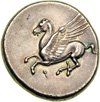 |
Corinthia. Corinth, c. 345-307 BC. AR Stater (8.56 g). Pegasus flying left, koppa below. Reverse: Head of Athena left, wearing Corinthian helmet decorated with laurel wreath; A - P flanking neck, to right, eagle standing left, head reverted. Pegasi I, p. 262, 426; Ravel 1008; BMC p. 26, 258; SNG Cop. 73. Portrait of delicate style. Attractive even toning, with slight colorful iridescence in the recesses. NGC graded About Uncirculated.
Estimated Value $700 - 800.
View details and enlarged photos
| Realized
$1,380 |
Lot 34 |
 |
Peloponnesos. Elis. AR Stater (11.91 g), struck c. 432 BC, for the 87th Olympiad. Eagle standing left on groundline, his wings raised up; a dead heron to left at his feet. Reverse: Nike seated left on a base set on a low, step-like pedestal, wearing long chiton and peplos, holding a long scepter in one hand and resting other hand on the pedestal; above and flanking, A F. Seltman 118 (BF/βσ); SNG Delepierre 2090; Weber 4027 (= Seltman 118b). High relief devices of excellent style, finely struck and centered. Handsome old toning. A superb example of this type, with the reverse device the finest preserved example known. Extremely Rare. NGC graded Extremely Fine.
There is considerable variety in the Olympian staters which feature the figure of Nike. On some, she personifies Victory holding a scepter (as here), or a palm branch; on another type of the 87th Olympiad she is either mourning or pensive, perhaps wondering if she will indeed be victorious. It is a splendid series of coins, issued for the games every four years, as now, held in late summer. It was then required that these special festival coins be used at the sanctuary, which necessitated going to bankers to exchange visitors' hometown mintages. A certain percentage was then given to the city for the next Olympiad. Presumably, this was only one of the many ways the games were made financially viable.
Estimated Value $30,000 - 35,000.
Ex BCD Collection, Leu 90 (5-10-04), lot 46; ex collection of H. de Nanteuil. Illustrated in Money of the World, coin 5.
View details and enlarged photos
| Realized
$48,300 |
Lot 35 |
 |
Kingdom of the Cimmerian Bosporos. Pharnakes II, 63-47 BC. Gold Stater (8.24 g), Panticapaeum mint, struck 53/52 BC. Diademed bust of Pharnakes right, with luxuriant hair. Reverse: Apollo, semi-draped, seated left on lion-footed throne, holding laurel branch over tripod, left elbow resting on kithara at his side; name and titles above and below, X monogram to right, EMS above (year 245, Pontic Era). Golenko & Karyszkowski, "The Gold Coinage of King Pharnaces of the Bosporus," in Numismatic Chronicle, 1972, no. 6 (same dies); Fr-156. Finely centered on a spacious, nearly round flan. Lustrous. Exemplary, sensitive portrait -- among the finest in this series. Very Rare. NGC graded About Uncirculated.
Pharnakes is, in general, little known to history, but for being the subject of an acerbic quip, made famous in Caesar's chronicles of the Civil Wars. Typical of the politics of the era, Pharnakes II, who was the son of Rome's implacable enemy, Mithradates VI, "the Great," forced his father to commit suicide in 64 BC to placate the Roman general Pompey, who had surrounded Pharnakes' citadel at Panticapaeum. In compensation Pompey granted Pharnakes the title King of the Bosporus and left him alone to his own devices. Meanwhile Rome went on to annex large swaths of the Middle East and Asia Minor.
With the death of the Armenian king Tigranes II, the Great, in 55/4 BC, Pharnakes felt safely ambitious enough to assume the deceased king's title of "Great King of Kings" - that seen on the above gold coin. Later, sensing opportunity at reclaiming some of the vast empire created by his father, Pharnakes quickly threw in his lot with Pompey when civil war broke out between Caesar and Pompey in 49 BC. His initial military successes in the area evaporated with Caesar marching north into Asia Minor in 48 BC, in order to restore the situation and avenge Roman losses. Pharnakes' army proved no match against Caesar's battle-hardened troops at the battle of Zela, in mid-47 BC, and were quickly routed. Thus Caesars' "Veni, Vedi, Vinci" -- one of the more famous literary quips to survive from antiquity.
Estimated Value $20,000 - 25,000.
At the time of the Numismatic Chronicle survey, Golenko & Karyszkowski had assembled a corpus of 15 known specimens of the Pharnakes gold coins, ranging in date from c. 55-50 BC. Since then a few more examples have surfaced, with a total known population probably not exceeding 25. Of these, 10 are located within museum collections. The famed Hunt specimen, with nearly as fine a portrait, but of a somewhat lower grade (Extremely Fine), realized $29,700 (including the 10% premium) in the Sotheby New York sale of June 19, 1990 (lot 115). Illustrated in Money of the World, coin 22.
View details and enlarged photos
| Realized
$83,375 |
Lot 36 |
 |
Pontos, Kings of. Mithradates VI, "the Great," 120-63 BC. AR Tetradrachm (16.61 g), dated August 95 BC. Diademed head of Mithradates right. Reverse: Pegasus grazing to left, above at left, star within crescent; around and to right: BAΣIΛEΩΣ MIΘPAΔATOY EYΠATPOΣ, plus date, along with monogram, and IA below; all within ivy wreath. Callatay D 20 / R I. Large, boldly fierce Hellenistic portrait on spacious flan. Very attractively toned -- the portrait ringed with bright iridescent colors. A superb example of his earlier dated coinage. NGC graded Uncirculated.
Estimated Value $3,500 - 4,000.
Illustrated in Money of the World, coin 23.
View details and enlarged photos
| Realized
$5,290 |
Lot 37 |
 |
Mysia. Kingdom of Pergamon. Eumenes I, 263-241 BC. AR Tetradrachm (16.90 g). Head of founder, Philetaerus, to right, diadem entwined with laurel wreath. Reverse: Athena seated left on elaborate bench, arm resting on shield with gorgoneion ornament, other holding transverse spear; name of ΦIΛETAIPOY at right; ivy leaf behind shield, bow to right, A on bench. Dewing no. 2207; Westermark Group III (V.XIII/R.3, same dies); SNG Cop. 334. Lightly toned. A superb example with splendid, bold portrait. NGC graded About Uncirculated.
Philetaerus was one of the more remarkable personalities of his era. Although recorded as being a eunuch (his gender resulting from a childhood accident), he proved to be a person of obvious capabilities. In spite of his handicap, he had risen to being a ranking officer in the army of Lysimachos during the wars of the Diadochi -- the decades long squabbles and bloodshed among Alexander the Great's "companions," (i.e., his top generals) who fought to carve up among themselves as much of their dead leader's empire as each could retain.
In any event, serving under Lysimachos as commander of his garrisons at Pergamon, he was entrusted with guarding 9000 talents (equal to $10,000,000 according to one source) that had been assembled for war expenses. However, according to Pausanius, because of the machinations of Lysimachos' most recent wife, Arsinoe, "…Philetaerus, to whom the property of Lysimachus had been entrusted, aggrieved at the death of Agathocles [son of Lysimachos, to whom Philetaerus was a devoted friend and supporter, and who had been killed at the behest of his new stepmother, Arsinoe] and suspicious of the treatment he would receive at the hands of Arsinoe, seized Pergamus on the Caicus, and sending a herald offered both the property and himself to Seleucus.[1.10.5]."
Thus in 282 BC he deserted Lysimachus, and now as a vassal and ally of Seleucus, used the money to establish himself as ruler of the state of Pergamon. Eventually, Lysimachus died without being able to put down this revolt, and Pergamon became the capital of a little principality. Partly by astute diplomacy, aided by the continuing dissensions among the rival kings, and other events, Philetaerus contrived to keep on good terms with his neighbors on all sides (283-263 BC). His nephew Eumenes (263-241 BC) succeeded him, and was able to increase the power, size, and independence of the kingdom. Pergamon was to become the capital of a considerable territory and a center of art and regal magnificence. It continued to rank for two centuries in wealth and influence, becoming one of the principal wellsprings of Hellenistic civilization and art.
Estimated Value $3,500 - 4,000.
View details and enlarged photos
| Realized
$6,325 |
Lot 38 |
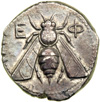 |
Ionia. Ephesus, c. 350-340 BC. AR Tetradrachm (14.78 g). Top view of a bee, E - Φ flanking. Reverse: Forepart of kneeling stag right, head reverted, palm tree at left; magistrate's name: ΠYPIΛAMΠHΣ at right. CH IX, pl. 27, O123 (same dies). Fully centered on large flan, thus complete devices. Toned. Some slight flatness to strike. Nevertheless, Rare in this quality. NGC graded Extremely Fine.
Estimated Value $2,500 - 3,000.
Ex NFA XX, March 9-10, 1988, lot 724.
View details and enlarged photos
| Realized
$8,625 |
Lot 39 |
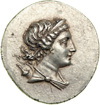 |
Ionia. Magnesia ad Maeandrum, c. 160-150 BC. AR Tetradrachm (16.50 g). Diademed bust of Artemis right, quiver over shoulder Reverse: Nude Apollo standing left, elbow resting against tall tripod behind, holding branch tied with fillet in his right hand; magistrate' name, EYΦEMOΣ ΠAYΣANIOY at left, ethnic at right, maeander pattern below; all enclosed in a laurel wreath. BMC Ionia, p. 162, 36; cf. Jones, "The Autonomous Wreathed Tetradrachms of Magnesia-on-Maeander," ANSMN 24 (1979), pp. 104-5, 8-22. SNG Cop. --; SNG von Aulock --; Weber 6003. Portrait of pretty style, well struck up, and in high relief. Reverse a little off center. NGC graded About Uncirculated.
This virtually mint state example of Hellenistic art was probably found in the Kirikhan hoard unearthed around 1971-2. Sometimes called a stephanephoros or "wreath-bearer," this denomination is so termed because of the large wreath encircling the reverse type. Other stephanephoroi (plural) discovered in this fabulous hoard were coins bearing the ethnics, or city-names, of Kyme, Myrina and Herakleia.
Estimated Value $2,000 - 2,500.
View details and enlarged photos
| Realized
$3,105 |
Lot 40 |
 |
Lydia, Kings of. Croesus, 561-546 BC. Gold Stater (8.05 g), Sardis mint, c. 550-546 BC. Light Stater Series. Foreparts of confronted lion, at left, and bull, at right. Reverse: Two incuse squares of unequal size. BMC 31-34; Traité I 401-403; BMFA 2073; SNG von Aulock 2875. Of remarkably elegant style, well centered, with virtually complete devices. NGC graded About Uncirculated.
Among the most historic of names and coins, the phrase "Rich as Croesus" still has some currency even today. The last of the Mermnad dynasty, Croesus enlarged his kingdom by subjugating the surrounding Greek cities of Asia Minor. At the pinnacle of his wealth and power, he decided to act on an ambiguous oracle by attacking the new and virile Persian Empire. The result was that the Persian king, Cyrus, quickly sacked Croesus' capital, Sardis, in 546 BC. The Lydian empire was just as quickly extinguished. The suddenness of his fall obviously impressed the Greeks to the extant that the name of Croesus became a catchphrase not only for unrivalled wealth, but also unmitigated hubris.
Estimated Value $4,000 - 5,000.
Illustrated in Money of the World, coin 1.
View details and enlarged photos
| Realized
$19,550 |
Lot 41 |
 |
Lydia, Kings of. Time of Darios I, c. 520/15-500/490 BC. AR Half Stater, or Siglos (5.40 g), Sardis mint. Croesid type. Foreparts of confronted lion, at left, and bull, at right. Reverse: Two incuse squares of unequal size. BMC Lydia, 41ff.; SNG von Aulock 2877ff. Well centered on very oblong flan, with virtually complete devices. A particularly fine example of this historical issue. NGC graded About Uncirculated.
The Lydian kingdom was wealthy, to the extant that one could visualize in our times, as having the wealth of a mega-nation. To the ancients it must have seemed legendary. The richest and most successful of the Lydian kings was the last, the fabled Croesus. In fact, a recorded gift of bullion and precious metal ornaments that was gifted to the shrine of Apollo at Delphi, home of the revered Delphic oracle, has been calculated to have contained nearly four tons of gold!
Likely the key to his and his empire's wealth was the development and employment of a bimetallic currency system -- the first in history. The earliest coins were made of electrum, a naturally occurring alloy of gold and silver. The obvious drawback is that the alloy was not always consistent, leaving a degree of variability to the coin's intrinsic value that could be hampering for transactions in the marketplace. Croesus began by refining his gold to about ninety-eight per cent purity, and then added a silver coin, for smaller transactions, with the silver pegged to a specific ratio to the gold -- at a rate already consistent with their market traditions. After some adjusting a rate was settled on of ten silver staters, of about 10.8 grams each, that would equal a gold stater of about 8.17 grams.
With this system of fixed rates and values, Lydian currency dominated the commercial life of the region. Croesus' Persian conquerors were so impressed by his coins that they adopted the Lydian system intact. Their only change being that their mainstay silver denomination was the half stater, or siglos (with its ratio of 20:1 in terms of silver to gold). With the siglos (still being uncovered to this day by the thousands throughout the Near East, and even in India), the Persian Great King paid his troops and built his empire.
Estimated Value $1,250 - 1,500.
View details and enlarged photos
| Realized
$2,099 |
Lot 42 |
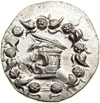 |
Lydia, Tralleis, c. 128-85 BC. AR Cistophoric Tetradrachm (12.71 g). Serpent emerging from Cista Mystica, within border of ivy leaves and fruit. Reverse: Two intertwined serpents flanking ornate bow case; ethnic at left, kithara at right, ΔION (magistrate) above bow case. SNG Cop. 657; SNG von Aulock 3259. A little weakness noted in the obverse wreath border, otherwise bold and highly lustrous -- as struck. NGC graded Choice Uncirculated.
Estimated Value $500 - 600.
View details and enlarged photos
| Realized
$750 |
Lot 43 |
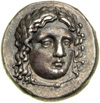 |
Satraps of Caria. Maussollos, 377-353 BC. AR Tetradrachm (15.12 g), Halicarnassus mint. Laureate head of Apollo three-quarters frontal, the clasp and hem of his chlamys visible at neck. Reverse: Zeus Labraundos standing right, resting double-bladed axe (labrys) on right shoulder, holding scepter in left hand; name to right, ME monogram at left. MMAG Auc. 61 (1982), lot 145 (same dies); Kraay-Hirmer 638 (= SNG von Aulock 2358) same obv. die; Hurter, Studies, Price, 152, and p. 33, 39. The superb portrait perfectly centered, with a regal yet pensive air. Toned. Rare. NGC graded Extremely Fine.
Prior to Alexander the Great's conquests, much of Asia Minor was under Persian domination, and was administered by governors or satraps under the direct control of Persia's Great King. Caria, on the southwest coast of present-day Turkey, was a far-flung and rich province that was more immersed and partial to Hellenic culture than towards the Persian of its overlords. Caria's satrap, Mausollos, exemplified this regional trait, with his love of Greek art very apparent in the above coin, with its splendid and inspired depiction of one of Greece's most favored gods, Apollo, who here is rendered in an especially fine style. However, what is perhaps the most renowned example exemplifying his artistic sympathies, was the large and richly sculpted tomb which was commissioned for him by his widow, Artemisia. The structure was so impressive in size and artistry that it was regarded as one of the seven wonders of the ancient world. In fact, it is from this monument and his name that we get the word, Mausoleum.
Estimated Value $6,000 - 7,000.
View details and enlarged photos
| Realized
$8,338 |
Lot 44 |
 |
Satraps of Caria. Hidrieus, 351-344 BC. AR Tetradrachm (15.22 g), Halicarnassus mint. Laureate head of Apollo three-quarters frontal, the clasp and hem of his chlamys visible at neck. Reverse: Zeus Labraundos walking to right, resting double-bladed axe (labrys) on right shoulder, holding downward pointing spear in left hand; I(?) behind at Zeus' foot, king's name to right. Cf. Babelon, Traité pl. XC, 8; cf. BMC p. 183, 1; and especially cf. SNG Berry 1113 for portrait style. Some trivial weakness to one leg of Zeus, otherwise a splendid, clean strike. An extraordinary issue within Hidrieus' usually handsome coinage. NGC graded About Uncirculated.
This especially noble type reminiscent of some of the late 5th or early 4th century BC Apollos seen on the famed and important coinage of Rhodes, and also of Caria. The Rhodian coins undoubtedly served as a model for the coins of Maussollos and his brothers, Hidrieus, and Pixodaros.
From 395-334 BC, the satraps ruling Caria for the Persians were drawn from the family of Hekatomnos of Mylasa, whose most famous member, both in antiquity and in the present day, was Maussollos. Maussollos moved his capital from Mylasa to Halicarnassus, enriched the city with noble structures and superb art, and of course earned a place in history for the elaborate tomb that bore his name and remains, the Mausoleum.
After the death of Artemisia, the widow of Maussollos, Hidrieus succeeded to the Satrapy of Caria, marrying at the same time his younger sister, Ada. After his death in 344 BC, Ada maintained the throne for an additional four years before the last and youngest brother, Pixodaros, ascended to rule. Hidrieus, like his older brother, showcased the wealth of the realm with notable building projects. Most importantly he made improvements to, and built anew, monuments at Labraundus, among the oldest religious centers for the region. There, the remains of his temple to Zeus Labraundos can still be seen today.
Estimated Value $12,500 - 15,000.
Ex von Hoffman Collection (Switzerland).
View details and enlarged photos
| Realized
$39,100 |
Lot 45 |
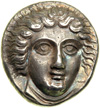 |
Caria, Islands off of. Rhodes, c. 404-385 BC. AR Tetradrachm (15.22 g). Facing head of Helios, inclined slightly to the right Reverse: Rose in profile with bud to left, wreath below right, Φ above; ethnic above; all in shallow incuse square. Ashton 35; Berend 40 (this coin). Finely centered, bold strike, on outstanding metal. Even gray patina over plentiful mint luster, with iridescent shades of deep blue, green and rose. Stunning portrait. The luxuriant wavy hair emulating the radiating solar rays later became a hallmark of his facing portraits. Very Rare, especially in this quality and preservation. NGC graded Choice Almost Uncirculated.
Facing heads are the most difficult to successfully engrave upon the dies. It takes a master celator to make the relief substantial and proportionate with the proper modeling of the sculptural object, which has been so beautifully accomplished in this compelling, large coin of Rhodes. Viewing a coin such as this through a stereo microscope is a treat, as the three-dimensional quality can be even more fully appreciated.
Estimated Value $25,000 - 30,000.
Ex de Guermantes Collection. Illustrated in Money of the World, coin 6.
View details and enlarged photos
| Realized
$41,400 |
Lot 46 |
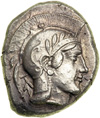 |
Dynasts of Lycia. Kherei, c. 410-390 BC. AR Stater (8.55 g), Telmessos mint. Helmeted head of Athena right, wearing crested Attic helmet decorated with four upright olive leaves and floral arabesque; symbol or Lycian character behind. Reverse: Bearded head of Herakles right, wearing lion skin headdress; flanking, "KHEREI TELEBHE" in Lycian script, the whole within incuse square. Mørkholm & Zahle II, 52; Falghera --; Traité --; BMC --; SNG Cop. Suppl. 451 var. (orientation of obverse symbol). Fully struck up and well centered with complete devices on usual oblong flan. Obverse die somewhat worn, but details superior to most of the recent market examples. The finely detailed head of Herakles is exceptional. A splendid example of this series. NGC graded Choice Uncirculated.
Estimated Value $3,000 - 3,500.
View details and enlarged photos
| Realized
$5,700 |
Lot 47 |
 |
Cilicia. Tarsos. Mazaios, as Satrap, 361-334 BC. AR Stater (10.83 g). Baal of Tarsos seated left, head facing, holding grapes, wheat ear, and eagle in right hand, scepter in left hand; Aramaic legend at right and below. Reverse: Attacking lion bringing bull to knees, left; Mazaios in Aramaic above; monogram below. SNG Levante 106; SNG France 335 var. Perfectly centered on full flan. Full, even strike, with all details complete. Toned and lustrous. NGC graded Choice Uncirculated.
Tarsos, the chief city of Cilicia, is situated on the east side of, and near the opening called the "Cilician Gates," a narrow gorge leading onto the Cilician plain. The plain was rather like the nexus point for trade routes across southern Anatolia (Turkey). Movement on the small plain was severely channeled by the impediments of the surrounding terrain. Thus, control of this area meant having control of all the trade going south from Europe -- to the Levant, and Egypt.
The origins of the area are rather obscure, but the region was part of the "cradle of civilization," with human settlement there dating back thousands of years. Because of its location the inhabitants were a polyglot mixture of locals, Greek and Phoenician settlers, plus the residue of assorted invading or migrating groups. Cilicia never survived for any length of time as a kingdom of its own. It was too much of a buffer state, too often the prey of, or suffering on the sidelines of, the power struggles of larger kingdoms or empires. Still, the area continued to remain fairly prosperous -- more so during the Persian Period, and continuing under Alexander the Great.
With the Seleucid Kings of Syria, Tarsos lost out to Antioch as the capital of the Seleucid Kingdom. This relegated Tarsos to the status, more or less, of a "frontier town." This did not mean it was a poor town by any means. Under the Romans, when Tarsos was made capital of the province of Cilicia, the city finally reached the pinnacle of its wealth and influence. Prosperous, cultured, and proud of its 'Greekness,' its most famous citizen (to the modern world), St. Paul, described himself with pride as "a citizen of no mean city."
Estimated Value $600 - 700.
View details and enlarged photos
| Realized
$2,070 |
Lot 48 |
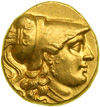 |
Syria, Seleucid Kingdom. Antiochos II, Theos, 261-246 BC. Gold Stater (8.52 g), Miletos (?) mint, struck c. 250 BC. Struck in the name of Alexander. Head of Athena right, with crested Corinthian helmet decorated with a serpent. Reverse: Nike standing left, holding wreath and palm; monogram in left field, AΛEΞANΔP[OY] at right. SC 548a = Price 3785 = A. Houghton, "Tarik Darreh (Kangavar) Hoard," ANSMN 25 (1980), 34 (this coin); WSM --; Müller --. Sharp, clean strike on tight flan. Small ancient bump on rim of helmet, otherwise choice; with very handsome art, and very lustrous. At present, Unique. NGC graded Uncirculated.
Estimated Value $3,000 - 3,500.
Ex CNG 54 (6-14-00), lot 484; NFA II (3-25-76), lot 119; Tarik Darreh Hoard.
Extremely rare, one of only two Alexandrine staters from this issue, and the only example with this control mark.
View details and enlarged photos
| Realized
$15,525 |
Lot 49 |
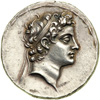 |
Seleucid Kingdom. Antiochos V, Eupator, 164-162 BC. AR Tetradrachm (16.73g), Antioch mint. Diademed head of youthful Antiochos right. Reverse: Zeus, in himation, enthroned left, holding scepter and Nike, who crowns king's name; monogram at left. Le Rider, Antioch, 111 = CH VIII, pl. LV, 2 (this coin); Newell SMA 75. Finely struck, elegant work. The portrait delicate, and superior for the series. Light attractive toning. NGC graded Uncirculated.
The rare coins of Antiochos V, Eupator, were struck at only a few Seleucid mints. They portray this son of Antiochos IV as either a boy or a youthful man, often with a certain idealism and upward gaze.
Estimated Value $3,500 - 4,000.
View details and enlarged photos
| Realized
$5,175 |
Lot 50 |
 |
Seleucid Kingdom. Antochos VIII, 121-96 BC. AR Tetradrachm (16.13 g), Ake-Ptolemais mint. Diademed head of Antiochos right. Reverse: Zeus Ouranios, in himation, stands left, holding scepter and star, crescent atop his head; regnal titles, M at left, the whole within wreath border. SNG Spaer 2554. Well-centered, stylish work. Beautifully toned, with fine iridescent coloring. NGC graded Uncirculated.
The final century of the Seleucid Dynasty was devoted in part to attempts at restoring pieces of empire lost to newer, more virile dynasties, and an even greater part to the fratricidal conflicts among the numerous heirs, successors, and claimants to the throne. In this respect, Antiochus VIII, nicknamed Grypus for his enormous beak-like nose, was a role model for his times.
The eldest son of Demetrius II and the redoubtable and ambitious daughter of Ptolemy VI, Cleopatra Thea, Grypus ascended to the throne in a joint regency with his mother after she had done away with her oldest son by Antiochus VII, Seleucus V (who was half-brother to Grypus). Their joint reign (125-121 BC) was preoccupied by the usurpations of Alexander II, Zebina. With Alexander's demise, Cleopatra chafed at sharing power with her maturing son. The oft told story has an aware and on guard Antiochus forcing his mother to drink before his eyes the poison draught she had prepared for him. After this, Grypus embarked on an undistinguished sole reign (121-96 BC) where he was mostly at war with his other half-brother by Antiochus VII, Antiochus IX, who was attempting to seize the throne for himself. Neither could gain an upper hand in their conflicts.
The once mighty Seleucid Kingdom had consisted of the wealthy and ancient empires of Near and Central Asia, encompassing modern day lands such as Afghanistan, Iran, Iraq, Syria, and Lebanon, together with parts of Turkey, Armenia, Turkmenistan, Uzbekistan, and Tajikistan. In the preceding decades it had become severely reduced. Now, with the two Antiochoi at each other's throats, the kingdom was reduced further -- into two parts.
The death of Grypus in 96 BC changed nothing. His sons and nephews continued in the Seleucid tradition, taking up arms against each other continually until Rome's Pompey the Great arrived in 64 BC and easily took over the exhausted and enfeebled kingdom.
Estimated Value $500 - 600.
View details and enlarged photos
| Realized
$2,160 |
|
|